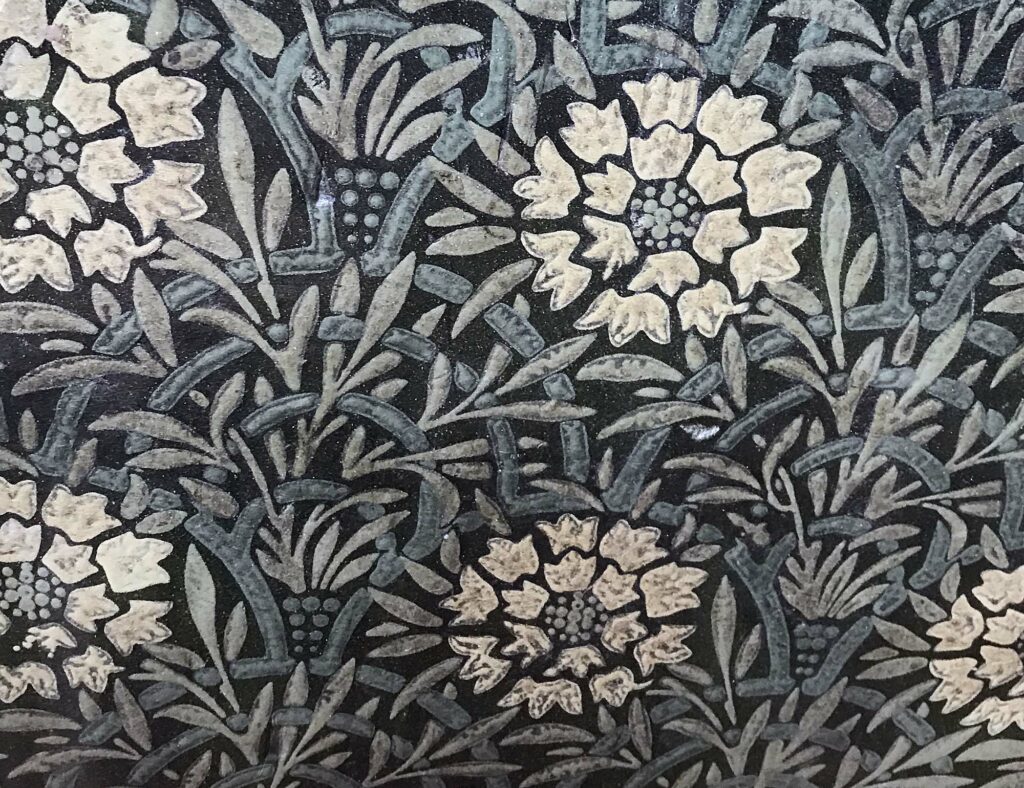Pioneer craftsman’s one-off design gets rare showing
A rare fragment of linoleum created by Victorian designer William Morris – saved from a skip in the 1970s – is to be exhibited at a Scottish museum.
The marigold-patterned floorcovering, rescued during a home clearance in London, features in an exhibition that celebrates Fife’s phenomenal success as a centre of linoleum manufacturing.
Morris’s striking design – showcased in Flooring the World at Kirkcaldy Galleries – was the only linoleum pattern that the Arts and Crafts movement’s pioneer ever produced.
It was his first design a floor covering – registered on 7 June 1875 – and pre-dating the development of his woven carpets after 1878.
Described in the Morris & Co catalogue of 1875 as ‘corticine floor cloth’, it was a popular floor covering, costing three pounds and 10 shillings per yard and sold in 72-inch widths.
It was produced in two different colour combinations – green and yellow, like the Kirkcaldy sample, and another that remains a mystery because the Morris catalogue was printed in black and white.
Very few examples of the linoleum remain. Usually laid in high-traffic areas, early versions were surface printed rather than inlaid, so the pattern would wear down and the linoleum would be discarded.
The William Morris Society – which rescued the fragment in the 70s – donated the fragment to cultural charity OnFife, which runs Kirkcaldy Galleries, last year. Curators now hope to establish precisely where the fragment was made.
Flooring the World, which opens on Wednesday (15 November), showcases a fascinating array of objects linked to one of Scotland’s most enduring industrial success stories.
Displays feature products made in Kirkcaldy – and the Fife villages of Falkland and Newburgh – which floored millions of homes, offices and public buildings worldwide.
Exhibits include a piece of congoleum – a felt-backed budget version of linoleum – which covered the hall of Paul McCartney’s childhood home in Liverpool.
Also on show is a delightful miniature elephant, created by pop art sculptor Eduardo Paolozzi in the 1970s for a marketing campaign to boost linoleum sales.
Among the many exhibits being displayed for the first time are photographs, pattern books, catalogues, samples and workers’ tools.
Linoleum, and its many variants, has been dubbed the most ubiquitous and democratic of floor coverings, bought by customers across the social spectrum.
The industry employed one in 10 of Kirkcaldy’s population at its peak in 1914 but, with consumers increasingly choosing vinyl flooring or carpets, just one factory was left by 1963.
One fashion trend was a dagger to the heart of the industry around that time – the stiletto heel. An advert reassuring customers of linoleum’s durability is included in the show.
Fife’s sole remaining linoleum factory – built by Kirkcaldy’s first floor covering manufacturer, Michael Nairn & Co – is still operational and owned by international flooring company Forbo.
The Swiss-based firm recently gifted OnFife its historical archive, which dates back to Nairn’s foundation in 1847.
Treasures include banners carried by Nairn’s staff on summer excursions, photographs of the company’s fire engine and a paint block, cut from a deposit of emulsion that had built up beneath a printing room floor.
Other curiosities include striking linoleum marquetry pictures. Among them are portraits of Queen Elizabeth and the Duke of Edinburgh, made by Kirkcaldy Linoleum Market and presented to the Town Council in 1955.
Also featuring in the exhibition is an arresting photograph of a strike that took place 100 years ago in a distant and little-known corner of a Fife-based linoleum empire.
Curators have now discovered the strikers were based at a factory in Normandy, which was owned by one of Kirkcaldy’s largest linoleum companies – Barry, Ostlere and Shepherd.
As well as detailing day-to-day working practices, the exhibition highlights the many musical bands, social clubs and sports teams linked to factories.
The exhibition is the culmination of a £115,000 social history project that has sought to engage people with OnFife’s globally renowned linoleum collection.
Recently recorded interviews with people who worked in the industry have helped to fill existing knowledge gaps and are a key part of the exhibition.
Among the interviewees is Danny Ferguson, a designer with Tayside Floorcloth Company in Newburgh in the 1960s. A hand-painted pattern designed by Mr Ferguson is being exhibited for the first time.
Curators had also been keen to speak to women workers – who played a greater role in production than in most other industries – and anyone who took part in industrial action.
Flooring the World is backed by the Esmée Fairbairn Collections Fund, which is run by the Museums Association and supports initiatives that help collections achieve greater social impact.
Exhibition curator Lily Barnes said: “Flooring the World has been an incredible opportunity to develop OnFife’s amazing linoleum collection, and we can’t wait to share the work we’ve been doing.”
Flooring the World runs from Wednesday 15 November 2023 to Sunday 25 February 2024.

Ends
For further information contact Sheona Small, press officer, 07809 727 989 or email sheona.small@onfife.com
Notes to editors: OnFife is a registered charity and manages and operates theatres, libraries, museums and galleries and cultural partnerships on behalf of Fife Council for people living, working and visiting Fife. Further information can be found at www.onfife.com
Keep in touch and up to date with all things cultural in Fife and beyond at:
Twitter: @onfife @onfifelibraries @onfifemuseums
Facebook:
www.facebook.com/onfife/
www.facebook.com/onfifelibraries/
www.facebook.com/ONatDCLG/
www.facebook.com/kirkcaldygalleries/
www.facebook.com/onfifearchives/
Website: www.onfife.com
